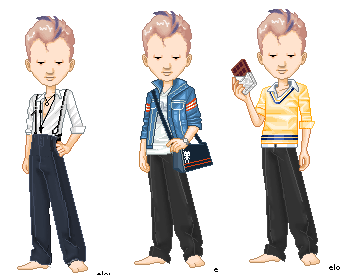Transmasc Style Tricks
A collection of fooling-the-eye fashion hacks for suggesting a particular silhouette. WIP.
(it goes without saying that like, you can dress however you like? & different things will work for different people. This page is specifically written for people who would like a slightly more cisnormative silhouette, for passing or pleasure)
Source:all dolls lovingly frankendolled from Elouai candybar's dollmaker 5Vertical proportion
Horiozontal lines divide the body into sections, like so:
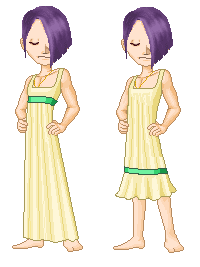
Concentrate on those two dolls, and think about the way your eye moves: jumping up to the regency waistline but down to the 20s waistline. The eye jumps to the horizontal line as focal point. This eye motion also causes us to subtly judge the dimensions of the areas. For example, the regency doll looks unaccountably taller than the 20s doll, who's a touch more on the childlike and frumpy side. Same doll, same height.
By thinking carefully about where we put our key horizontal lines, we can adjust how our proportions are perceived.
Colour blocking




What is it?
A jumper or t-shirt with three bold blocks of colour: a white stripe on the upper chest, light-coloured beige over the shoulders and arms, dull navy on the midriff
Why it works?
When you look at a garment, your eyes go on a journey. This jumper is designed to lead the eye in a certain, predictable, and flattering pattern. Male upper bodies tend to have the shape of an inverted pyramid, and so the aim of this jumper is to make you look like you work out your shoulders more than you do. It also brings the attention to the face. I actually saw a guy not only wearing this jumper, but wearing a t-shirt in an identical pattern underneath (don't do this, it's not cool).
Your eye jumps straight to that bold white line, causing you to overestimate the size and importance of the upper body. It then moves to the next brightest area - the beige. The wide bateau neck, and the horizontal motion of your eyes along the top of the chest and arms emphasises the width of the shoulders. It sort of ignores the navy, which your brain therefore discounts as smaller.
I've done a couple of recolours of the garment, in subtle trans flag shades and fuck-you-terfs GQ pride, to show that this trick is less about the colours than the tones. The basic principle will always work: keep your least eyecatching, dullest, darkest colour below the line of the chest, and put the lightest and most vibrant colours at the top. You will be reliant on what you can find at the stores, of course, but when you do see a t-shirt or jumper with this layout of colour blocks you will now be able to think aha! I know what that's for, and why I want one.
High Waistlines
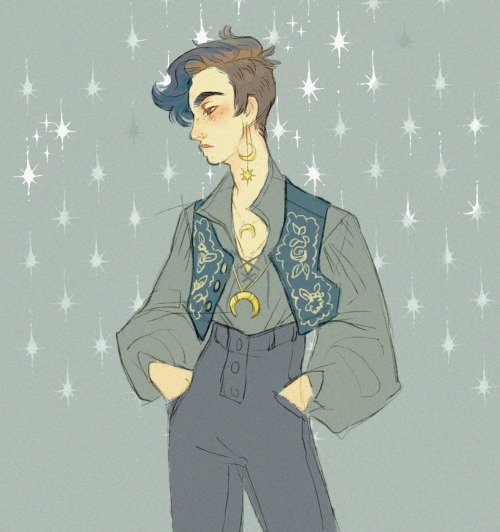 Source:Marlowe Lune on Twitter
Source:Marlowe Lune on Twitter
What is it?
Dark-coloured trousers cut high so they sit on the true waist, combined with an "over-sized" baggy silhouette on the top.
Why it works?
Marlowe Lune is a master of the transmasculine id, creating gorgeous digital art made of dreaming. I don't know if this is intended as a self portrait, but whenever they share selfies they're immaculately well dressed and clearly have a distinct eye for style.
At first instinct, you might think high waisted trousers are a Mistake. After all, you've probably got some hip going on that you want to think about less. Keeping the trousers in a dark colour will draw your eye to the upper body - like with the colour-blocked jumper - and make the brain read the hips as smaller. My husband keeps mordantly commenting that he's not really a goth, it's just that black is slimming; and lo! he's kinda right about that. More importantly, the waistline of a trouser is often eyecatching - it has belts, it causes a horizontal "breakline", it might have pockets. It's a place the eye will be drawn. So, if you have a low-waist or hipster trouser, that attention is going to go...straight to your hips. But put the waistline higher, and the eye should be drawn higher too - discounting the size of your hips in favour of the exciting details of the waistline.
High-waist trousers have a second important function. You want to persuade onlookers that the upper half of your body is disproportionately small, and your legs are disproportionately long. If you've ever noticed how many trans women like tunic dresses and long-cut t-shirts which cover the belt and hips - now you know why. By increasing the length of their upper body colour block, it tricks the eye into re-evaluating the body as longer in the top half and shorter down below. We want to do the opposite of that! By placing a horizontal line on the true waist, the viewer will overestimate leg length and underestimate torso length. It'll also help us drive the eye up towards the shoulders again.
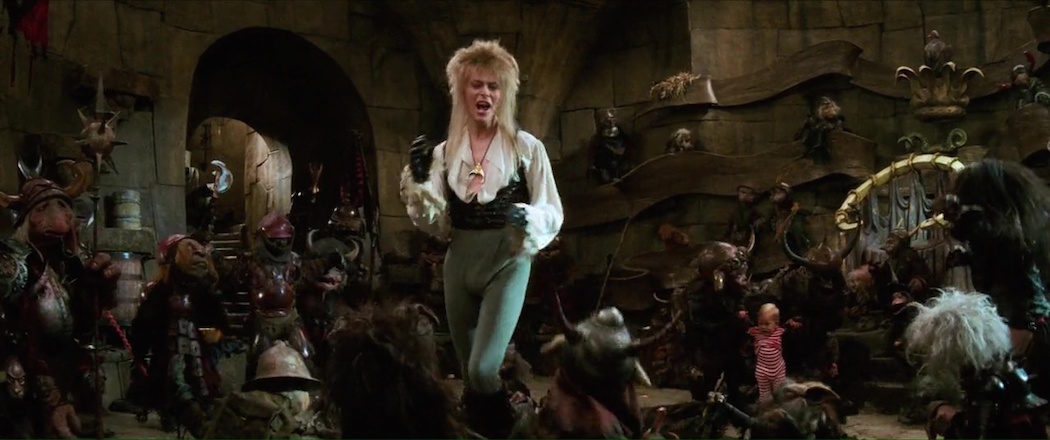
It's also true that high-waist trews will make you look a bit like Bowie in Labyrinth, something I can only assume we all want in our hearts. High waist trousers were the norm in the Victorian period, all the way up to the 50s - and continue to be a very elegant form of menswear, something that looks a little special.
Here's what NOT to do:



On the left, a very unflattering self-portrait of how I've been going wrong with verticals. Can you spot the error?
In the middle, a possible fix
On the right, a frankendolled copy of the original image, just for fun
My goal with my beloved red jacket was to make my upper body seem shorter. This is similar to what Lune does; that short-cut waistcoat in the illustration is a key style feature which helps define a shorter upper body length. But it's a disaster, because I'm still wearing long t-shirts, hipheight trousers, or both. This creates a rectangular shape smack in the middle of the body, and that immediately pulls the eye to the Worst Possible Place. In fact, this is almost a classic example of what NOT to do.
(Or, frankly, really quite close to what a trans woman might want to aim towards: lots of horizontal lines to reduce height, definite sense of downplunge around the waist, a pyramid with a wide base, a lengthening of the torso. I've known so many women who, by chance or design, go for this layering and overlap look.)
My instinct with the jacket wasn't bad: it is good to have bold, bulky, short shapes on the upper body. But without high-waisted trousers, it has no impact - in fact, it may even make things worse. A possible fix, where high-waist trousers are too silly and dressy, would be to make sure that bright white rectangle is as dull and dark as possible.
I want to add at this stage that Lune's image is a fashion drawing; in other words, they have far more leeway to just push the proportions of an image than we have in reality. Nontheless, look at the progression of those three dolls - from the "lowest" cut waist, on my horrible self-portrait - to the highest, in the doll-version of Lune that is at its most exaggerated. To my eye, at least, the final doll has the cleanest and most exciting silhouette; a sort of 1990s Brett Anderson to my lazy drag king's first tour out. It's the same underlying doll body in all three images, but doll!Lune has a sleekness and elegance that the lower waistlines lack.
Be Careful With Belts
We are thinking about horizontal lines. A belt makes the horizontal line into a STATEMENT. That means it's essential to consider carefully.
As a general rule, if you're slight pick a slender belt; if you're chunky, something with heft and presence. Think about texture: I recommend a matt belt with a subtle buckle over a shiny belt with a prominent one, as we don't ever want that waist line to be the focal point. Traditionally, you match your belt to your shoes.
Another option is suspenders. These can look sophisticated (if dressy) if you choose them well. The key benefit is that it eliminates that horizontal focal line entirely, and if they are visible (in formal wear, they should never be visible) they add vertical lines too for extra height & rectangularity. They can also help disguise a poorly fitting pair of trousers (i.e. if you pick a large size to fit your seat but then have a baggy waistband).
A third option is to get trousers adjusted to fit at the waist. Then it's possible you can wear them without a belt at all, esp if you add side-buckles.
Manbag
get a manbag. Tho having all these pockets at long last is wonderful, putting bulky things in them counteracts the work you've done to construct a silhouette. Wallets in front or side trouser pockets are a big no no if you worry about hips.
Billow
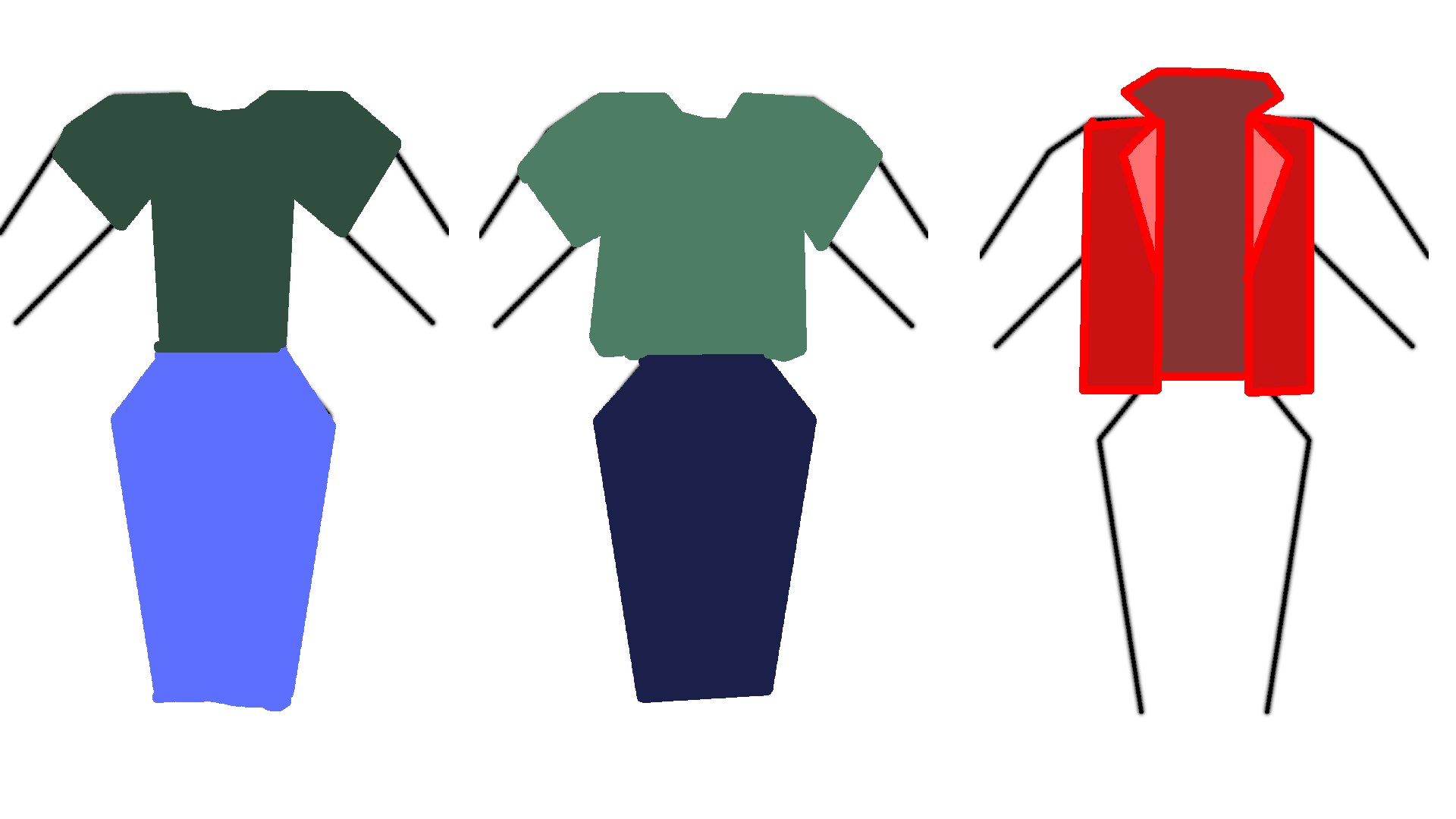
Another hack to disguise waist-to-hip proportion is picking upper body garments which billow or are wide around the waist.
The first sketch here is what not to do: a tight fitting t-shirt in a dark colour, plus trousers in a bright colour. Even though the trousers come to the waist, the tight t-shirt reveals the waist-to-hip ratio, making it a focal point. It is totally unforgiving, especially if you're hiding a binder as well. If you want to wear this shirt, add a jacket.
The second image is a smarter fit. By picking a shirt that billows a little around the waist, it creates more of a tubular overall look. If you're a stickler for fitting your shoulders correctly, these are tricky to come by as anything fitting sleeves well will be tight on the waist, and vice versa - you're looking at buying an over-size shirt and adjusting it down, a major task. But I find muscle tanks are great for this, as the armholes are supposed to be big, as well as poet style shirts.
It could also represent a cut-off tee, cut to hover at more or less exactly your waist height and not tucked in at all. A bold look, but I've seen fellows online do this well with gothy/punky looks.
The last image is of a short jacket - again, see how it reinforces a rectangular shape and distracts from the hourglass.
Always keep shirts tucked in, otherwise it will create a lower waistline & downplunge.
"Hard" Tailoring
A lot of transmascs start by looking at the more masculine options available in the ladieswear department. Either because they're not out but find that calling to them, or out but struggling with fit in the mens.
One of the problems with this is that women's tailoring is often "softer" than mens' - using thinner or more fluid fabrics, and less interfacing. Here's an example - Geena Davis in The Fly (1986), designed by Denise Cronenberg:

firstly, I've chosen this because her costuming in this film is just so luminous. But look at how her shirt and suit jacket drape her upper body, how much motion and elegance it has. It's delicious, and it is NOT what you want. You can see the lapel of her shirt is not interfaced or stiffened, and neither are the lapels on the jacket; there's no stiffness or shoulderpads in the shoulder, no rigidity in the body; the cuffs are, subtly, higher up the arm; the fabric is likely both a little thinner and softer. This is 100% an ensemble for a woman.
There's no easy way to get around this: either shop in the mens, or learn to tailor and hack womenswear. However, I mention it because...I got a lot of this kind of clothing in my wardrobe of shame, and it's only since learning to tailor I've recognised why it never satisfied me. Getting a good eye in means being able to assess formalwear in this way, to check if it's stiff enough. Fner. There are traditions of soft tailoring within menswear, of course; but if you've got some ladieswear and a strange dissatisfaction about what's not working, it's probably this more than the cut or fit.
Bateau Necklines
I can think of basically no context in which men get to wear bateau necklines except those saucy Jean Paul Gaultier ads from the 90s:

Bateau necklines are flat and wide, and one of the sexiest design features in the world. They're good for the anxious transmasc because, like the beige colour block, they draw the eye wide across the shoulderline, making your shoulders seem bigger and broader.
So what kinds of male garment contains these neckline? Basically zero, but look: there's more to life than passing. If we have an androgynous personal style or are choosing clothes for our own comfort, these necklines are genuinely fantastic.
Some t-shirts will have a subtle bateau shape to the neckline instead of a round. Like this:

Both of these tshirts you could plausibly find in the store. But the one on the right has a slightly more bateau neck, and is thus a little more forgiving than the roundneck. I've also adjusted the sleeves. On the first t-shirt, the sleeves are floppy and paradoxically make yr arms seem narrower. But you can get "athletic cut" t-shirts where the arms are tighter, and those look more flattering
You don't need a literal bateau to get this impact; as long as the motion of the eyes starts in the center and travels outwards. Big statement necklines and wide-set straps also grant this property:
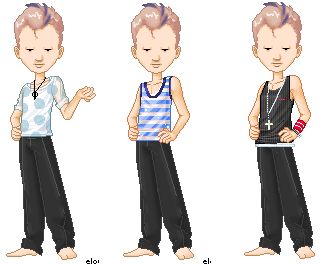
In contrast, narrow round necklines draw the attention from the shoulders to the center. It's the opposite motion - drawing the eye in, making you shrink. So too is having your boldest block of colour on the torso, but nothing of interest on the shoulders and arms. Your eyes travel lengthways, not crossways; this amplifies the torso problem and acts against your horizontals in the upper body. And, again, it causes the eye to go inwards to the focal point, not outward to your broad shoulders. Perhaps this is just me, but I've never felt great in these kinds of silhouettes:

Sorry boys, I know you're dreaming of wearing that sweater; I've never managed to make mine work
Wide collar/rolled sleeves
By now, I guess you'll be spotting certain patterns in what parts of the body we want to emphasise and de-emphasise.
One way to get that nice inverted-pyramid shape is by rolling up your sleeves. This creates a triangle of colour! In the previous section, we discussed why things drawing attention inward to your neck was a mistake.
Obviously, the classic shirt collar is a detail which does this - so a workaround is to choose wide-spread collars and wear them open, creating an impact like the bateaux. Now, keep in mind as you do this that things do still need to be in proportion to you. If your collar is too huge, it'll make you seem tiny; but what you're looking for is a reinforcement of the v shape, or a sense of "wideness". Here's a couple of nice examples:
